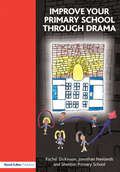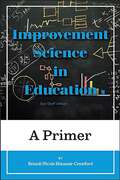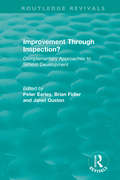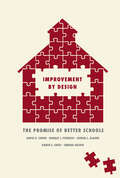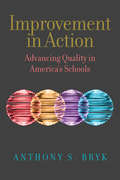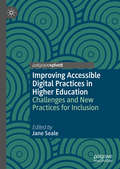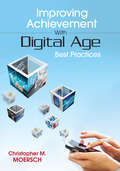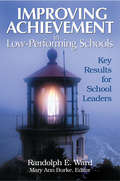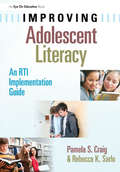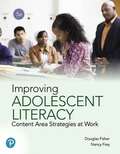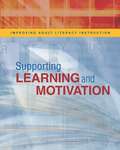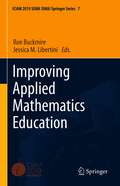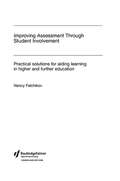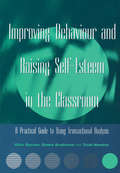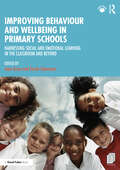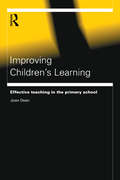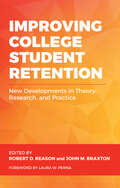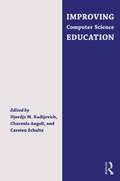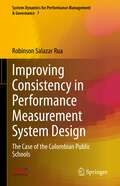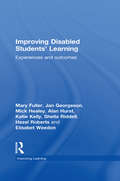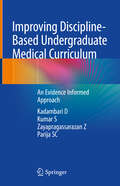- Table View
- List View
Improve your Primary School Through Drama
by Rachel Dickinson Jonothan NeelandsUsing drama right across the curriculum to improve and invigorate teaching and learning, this book provides whole school and individual class approaches underpinned by sound theory and implemented in a real primary school. Explanations and examples are given in a clear and accessible style, and links are made to The National Strategy. The book illustrates a wide range of strategies that show how drama can help with: behavior inclusion and multicultural issues improving the whole school ethos involving parents and governors. This user-friendly and comprehensive text is the perfect support tool for teachers and managers ready to improve their school regardless of whether they're approaching drama for the first time or are already passionate about it.
Improvement Science in Education: A Primer (Improvement Science in Education and Beyond)
by Brandi Nicole Hinnant-Crawfordmprovement Science in Education: A Primer provides a comprehensive overview of improvement science as a framework to guide continuous improvement and reconceptualizes improvement by centering equity and justice as the purpose of improvement. This Primer is designed to introduce improvement science, a methodology with origins in manufacturing, engineering and healthcare, to educational audiences. The book first explores the philosophical and methodological foundations of improvement science, juxtaposing it with traditional forms of research so that clear distinctions can be drawn. Chapters in the latter half of the book introduce the principles of improvement, give guidance and tools for operationalizing the principles in practice, and conclude with questions to ensure you are improving with equity in mind. Constantly reminding readers to think about who is involved and impacted, the Primer makes improvement science accessible to novices and adds critical dimensions for experienced practitioners to consider.
Improvement Through Inspection?: Complementary Approaches to School Development (Routledge Revivals)
by Peter Earley Janet Ouston Brian FidlerOriginally published in 1996, the title of this book poses the question whether the motto of the Office for Standards in Education was an apt statement of its effects in practice. Beginning with the state of knowledge about OFSTED’s early impact, the Editors review the range of complementary approaches to school improvement – most of them driven by the schools themselves – that were in operation, alongside the OFSTED system of inspection at the time. The major part of the book is taken up with the main ‘quality initiatives’ that were at work in primary and secondary schools – including Investors in People, Deming, TQM, partnerships, professional competence, strategic planning and effective governorship. Each chapter examines critically – sometimes with the aid of case studies of good practice – the benefits such approaches might bring to schools in their attempts to raise standards. The book is a companion to OFSTED Inspections: The Early Experience by the same Editors, published and reissued simultaneously.
Improvement by Design: The Promise of Better Schools
by David K. Cohen Donald J. Peurach Joshua L. Glazer Karen E. Gates Simona GoldinOne of the great challenges now facing education reformers in the United States is how to devise a consistent and intelligent framework for instruction that will work across the nation’s notoriously fragmented and politically conflicted school systems. Various programs have tried to do that, but only a few have succeeded. Improvement by Design looks at three different programs, seeking to understand why two of them—America’s Choice and Success for All—worked, and why the third—Accelerated Schools Project—did not. The authors identify four critical puzzles that the successful programs were able to solve: design, implementation, improvement, and sustainability. Pinpointing the specific solutions that clearly improved instruction, they identify the key elements that all successful reform programs share. Offering urgently needed guidance for state and local school systems as they attempt to respond to future reform proposals, Improvement by Design gets America one step closer to truly successful education systems.
Improvement in Action: Advancing Quality in America's Schools (Continuous Improvement in Education Series)
by Anthony S. BrykImprovement in Action, Anthony S. Bryk&’s sequel to Learning to Improve, illustrates how educators have effectively applied the six core principles of continuous improvement in practice. The book highlights relevant examples of rigorous, high-quality improvement work in districts, schools, and professional development networks across the country. The organizations featured in the book have addressed, with remarkable results, long-standing inequitable educational outcomes in high school graduation rates, college readiness, and absenteeism. The cases emphasize the measures the educators took and the thinking that motivated their actions. Bryk describes how improvers, working in different contexts and confronting different problems, used select principles, tools, and methods to make improvement come to life. Brief analytic reflections are embedded throughout the narratives, and each chapter concludes with an analysis of a set of larger lessons illuminated by the organization&’s story. Taken as a set, these examples offer readers valuable insights about the actual dynamics of doing improvement work.Improvement in Action, paired with Learning to Improve, provides readers with a comprehensive understanding of the practice, method, and theory of large-scale continuous improvement in education.
Improving Accessible Digital Practices in Higher Education: Challenges and New Practices for Inclusion
by Jane SealeThis book examines the role played by technologies in removing the disadvantage experienced by students with disabilities in higher education. Addressing five key themes, the editor and contributors explore the practices required of stakeholders within higher education institutions to mediate successful and supportive relationships between disabled learners and their technologies. Ultimately, the book argues that practice in the fields of disability, ICT and higher education is still not providing consistent and widespread positive learning experiences to students with disabilities. In order to address this situation, the field needs to creatively integrate knowledge gained through both research and practice, and to re-imagine what is needed for ICT to meaningfully contribute to a reduction in disadvantage for disabled students. This book will be of interest and value to scholars of disability studies, education and accessibility, and educational technologies.
Improving Achievement With Digital Age Best Practices
by Christopher M. MoerschConnect Common Core, inquiry, and technology! While technology ushers in exciting and innovative educational opportunities, finding best practices for complete integration remains a challenge. In this practical resource, educators will discover a roadmap for implementing digital age best practices. With discussions on how to promote networked collaboration, bolster purposeful inquiry, and anchor student decision-making and learning with digital-age tools, these research-based strategies deliver: A user-friendly road map for digital transition into new Common Core Standards Lesson plans, benchmarks, and instructional units to bridge the link between 21st century skills, Common Core Standards, and student achievement Practical tips for classroom, building, and district implementation Tools and guidance for successful PLCs
Improving Achievement in Low-Performing Schools: Key Results for School Leaders
by Dr Randolph E. Ward Mary Ann BurkeFocus on improving achievement, aligning teaching and learning with student performance, creating secure facilities, and forging links with the community with this excellent resource.
Improving Adolescent Literacy: An RTI Implementation Guide
by Pamela Craig Rebecca SarloMeet your students' literacy needs with this book from Pamela Craig and Rebecca Sarlo. Literacy experts Craig and Sarlo explain how the implementation of a Problem Solving/Response to Intervention framework in grades 4-12 will help all students greatly improve their reading skills. Written for secondary teachers and administrators, the book shows how to use PS/RTI as a tool for establishing achievable goals identifying barriers developing action plans monitoring the effectiveness of the intervention Each chapter includes research-based resources and practical guidance to ensure success.
Improving Adolescent Literacy: Content Area Strategies at Work
by Douglas Fisher Nancy FreyStraightforward, affordable, and practical, Improving Adolescent Literacy gives all middle and secondary school teachers instructional routines that will allow them to develop the content literacy skills of their students. Chapter-opening vignettes from actual classrooms show readers effective teaching in action and give them a look at how the chapter’s instructional approach works within content area teaching. Research-based rationales for each strategy follow the vignettes and provide an in-depth look at how to implement the strategy, along with examples of each strategy across the curriculum. In this 5th Edition, the authors provide new classroom examples from their colleagues across the disciplines as well as new instructional routines that have been researched and validated since the publication of the last edition. Also, this edition has been re-organized, adding three new chapters, to focus on the ways in which teachers can use reading, writing, speaking, and listening in their classes, emphasizing reading and comprehending texts, creating graphic organizers, developing vocabulary knowledge, and writing to learn.
Improving Adult Literacy Instruction
by Committee on Learning Sciences: Foundations Applications To Adolescent Adult LiteracyMore than an estimated 90 million adults in the United States lack the literacy skills needed for fully productive and secure lives. The effects of this shortfall are many: Adults with low literacy have lower rates of participation in the labor force and lower earnings when they do have jobs, for example. They are less able to understand and use health information. And they are less likely to read to their children, which may slow their children's own literacy development. At the request of the U. S. Department of Education, the National Research Council convened a committee of experts from many disciplines to synthesize research on literacy and learning in order to improve instruction for those served in adult education in the U. S. The committee's report, Improving Adult Literacy Instruction: Options for Practice and Research, recommends a program of research and innovation to gain a better understanding of adult literacy learners, improve instruction, and create the supports adults need for learning and achievement. Improving Adult Literacy Instruction: Developing Reading and Writing, which is based on the report, presents an overview of what is known about how literacy develops the component skills of reading and writing, and the practices that are effective for developing them. It also describes principles of reading and writing instruction that can guide those who design and administer programs or courses to improve adult literacy skills. Although this is not intended as a "how to" manual for instructors, teachers may also find the information presented here to be helpful as they plan and deliver instruction.
Improving Adult Literacy Instruction: Supporting Learning and Motivation
by M. ChiangVirtually everyone needs a high level of literacy in both print and digital media to negotiate most aspects of 21st century life-succeeding in a competitive job market, supporting a family, navigating health information, and participating in civic activities. Yet, according to a recent survey estimate, more than 90 million adults in the United States lack the literacy skills needed for fully productive and secure lives. At the request of the U. S. Department of Education, the National Research Council convened a committee of experts from many disciplines to synthesize research on literacy and learning in order to improve instruction for those served in adult education in the U. S. The committee's report, Improving Adult Literacy Instruction: Options for Practice and Research, recommends a program of research and innovation to gain a better understanding of adult literacy learners, improve instruction, and create the supports adults need for learning and achievement. Improving Adult Literacy Instruction: Supporting Learning and Motivation, which is based on the report, describes principles of effective instruction to guide those who design and administer adult literacy programs and courses. It also explores ways to motivate learners to persist in their studies, which is crucial given the thousands of hours of study and practice required to become proficient. The booklet concludes with a look at technologies that show promise for supporting individual learners and freeing busy adults from having to be in a particular place in order to practice their literacy skills. Although this booklet is not intended as a "how to" manual for instructors, teachers may also find the information presented here to be helpful as they plan and deliver instruction.
Improving Applied Mathematics Education (SEMA SIMAI Springer Series #7)
by Ron Buckmire Jessica M. LibertiniThis book presents various contemporary topics in applied mathematics education and addresses both interested undergraduate instructors and STEM education researchers. The diverse set of topics of this edited volume range from analyzing the demographics of the United States mathematics community, discussing the teaching of calculus using modern tools, engaging students to use applied mathematics to learn about and solve problems of global significance, developing a general education course for humanities and social sciences students that features applications of mathematics, and describing local mathematical modeling competitions and their use in providing authentic experiences for students in applying mathematics to real world situations. The authors represent diversity along multiple dimensions of difference: race, gender, institutional affiliation, and professional experience.
Improving Assessment through Student Involvement: Practical Solutions for Aiding Learning in Higher and Further Education
by Nancy FalchikovThe assessment of students an activity central to the role of any professional in further and higher education, and is an area that is the subject of constant innovation and debate. This book provides a scholarly account of the many facets of assessment, with a particular focus on student involvement. Peer and self-assessment are powerful assessment tools to add to the existing tutor-based methods of assessment and feedback, and this book is a comprehensive guide to the the methods and issues involved.Practical and accessible in style, yet grounded in research and rich in evidence-based material, Improving Assessment Through Student Involvement will be valued by all FE or HE professionals wanting to enhance both the effectiveness and quality of their assessment methods.
Improving Behaviour Management in Your School: Creating calm spaces for pupils to learn and flourish
by Tim DansieImproving Behaviour Management in Your School provides a common sense approach to understanding the causes and triggers of students’ challenging behaviour and equips teachers and school leaders with simple tools that can be easily implemented in any school. In his accessible and upbeat style, Tim Dansie uses case studies throughout the book which draw on strategies based on CBT and mindfulness. These strategies have proven to make a huge difference to school life and to how challenging students are managed. Teachers are encouraged to question how schools and classrooms are structured, in order to create environments where all students have the greatest possible opportunity to learn and grow as individuals. This resource includes accessible chapters about: What are the challenging behaviours? What are the causes of challenging behaviours in students? How to work with parents How to get staff on board This is a must-read for all practising and training teachers who wish to understand the reasons for challenging behaviour and how to improve it.
Improving Behaviour and Raising Self-Esteem in the Classroom: A Practical Guide to Using Transactional Analysis
by Giles Barrow Emma Bradshaw Trudi NewtonThis book will help all teachers who face challenging behavior in their classrooms. It offers support and guidance for dealing with issues of behavior and offers suggestions for building creative relationships in school. Through a combination of case study illustrations of key Transactional Analysis concepts, practical proformas, planning notes and resources that have been tried and tested with schools it will give you the confidence and skills necessary to develop effective classroom management.
Improving Behaviour and Wellbeing in Primary Schools: Harnessing Social and Emotional Learning in the Classroom and Beyond
by Jean Gross Sarah SeleznyovThis accessible resource provides a vivid and practical guide to social and emotional learning and will help primary schools tackle and improve behaviour and wellbeing. With content written by teachers and used successfully in real classrooms, chapters include powerful stories from teachers about their work and the impact it has had. Developed within a theoretical framework of evidence-based strategies, the resources included are fully illustrated with photographs from classrooms and draw upon a useful bank of downloadable resources and proformas. Taking the reader through a journey of how a group of schools worked together to develop practical and effective approaches, this essential resource features: Tried and tested strategies for improving behaviour and wellbeing Ready-to-use classroom resources – lesson slides; top picture-books for teaching about emotions; 20 simple exercises to help children stay calm; playground conflict resources and a progression in learning emotion vocabulary from Reception to Year 6 Powerful stories from individual teachers about their work and its impact An in-depth understanding of research evidence on what works in tackling social, emotional and mental health needs from best-selling author and expert Jean Gross Children’s social, emotional and mental health needs have never been of more concern to teachers than they are now — this book genuinely brings theory to life and is essential reading for today’s primary teachers, SENCOs, support staff and safeguarding leads.
Improving Children's Learning: Effective Teaching in the Primary School
by Joan DeanHow can teachers improve what they do in the primary classroom? Which teaching methods will help you and your pupils to perform effectively? These are the questions that every teacher will be asking him or herself in today's climate of targets and tables. Much research over recent years has focused on the role of the teacher and how effective classroom practice is achieved. The book discusses many areas of topical importance including: teaching methods motivating learners and matching work to children how to structure children's learning classroom control and organisation teaching literacy teaching children with special education needs working with parents. It also looks at the increasing role of the teacher as a researcher and how colloborative practices are providing a way for teaches to appraise both their own progress and that of their colleagues. This book should be of particular interest to the classroom teacher who is looking for ways to develop his or her teaching but has limited time to explore the research. It sets out to translate the findings of research into practical terms which teachers can easily use.
Improving Classroom Learning with ICT (Improving Learning)
by Peter John Rosamund Sutherland Susan RobertsonImproving Classroom Learning with ICT examines the ways in which ICT can be used in the classroom to enhance teaching and learning in different settings and across different subjects. Weaving together evidence of teachers’ and learners’ experiences of ICT, the authors: explain why the process of integrating ICT is not straightforward; discuss whether hardware and infrastructure alone are sufficient to ensure full integration and exploitation of ICT investment; emphasise the pivotal role that teachers play in supporting learning with ICT across the curriculum; argue that teachers need a greater understanding of how to put ICT to use in teaching and learning; highlight that out-of-school use of ICT has an impact on in-school learning; consider what kinds of professional development are most effective in supporting teachers to use technologies creatively and productively. Case studies are used to illustrate key issues and to elaborate a range of theoretical ideas that can be used in the classroom. This book will be of interest to all those concerned with maximising the benefits of ICT in the classroom.
Improving College Student Retention: New Developments in Theory, Research, and Practice
by Robert D. Reason, John M. BraxtonHigher education institutions have already begun to see decreasing enrollment numbers, even as higher education enrollment is predicted to drop precipitously starting in 2025. Much of the decrease in enrollment will be driven by demographic trends about which higher education institutions can do little, making the retention of students who do enroll that much more important. Overall retention rates have stagnated and differential retention rates by race and ethnicity have persisted. If higher education institutions, researchers, and policy makers are to improve retention rates, a critical examination of the current state and future directions of retention research is essential.This edited volume begins that examination by addressing several questions: What are the needed directions in theory and research on college student persistence and how do we translate new theory and research into effective practices? Are we asking the right questions, looking in the right places, or trying to apply out-of-date theories to new populations? In short, how can the research community help institutions improve retention in this challenging time?
Improving Computer Science Education
by Charoula Angeli Djordje M. Kadijevich Carsten SchulteImproving Computer Science Education examines suitable theoretical frameworks for conceptualizing teaching and learning computer science. This highly useful book provides numerous examples of practical, "real world" applications of major computer science information topics, such as: • Spreadsheets• Databases• Programming Each chapter concludes with a section that summarzies recommendations for teacher professional development. Traditionally, computer science education has been skills-focused and disconnected from the reality students face after they leave the classroom. Improving Computer Science Education makes the subject matter useful and meaningful by connecting it explicitly to students' everyday lives.
Improving Concentration: A Professional Resource for Assessing and Improving Concentration and Performance
by Roy BaileyImproving Concentration has been designed to help individuals improve their concentration skills. It is aimed primarily at those taking on a training role in relation to the individual concerned. However, it can also be used by the individuals themselves as a self-help resource. This resource will help trainers to convey to their students: an understanding of concentration how concentration works for them how to improve their concentration skills how to manage concentration in relation to their performance. This Psychological skills training resource is arranged in a format that is both easy to use and clear to follow. The activities can be used with both individual students and groups Part 1 'The knowledge base' outlines theoretical perspectives on concentration and describes the Bailey / Brown model of concentration. Part 2 'Pathways to improving concentration' explains and describes how the Bailey / Brown model of concentration can be used as a guide to raising awareness, understanding, monitoring and evaluating interventions aimed at improving concentration in people. Part 3 'The activities' in this resource can be used singly or combined as part of a structured intervention to improve an individual's concentration skills.
Improving Consistency in Performance Measurement System Design: The Case of the Colombian Public Schools (System Dynamics for Performance Management & Governance #7)
by Robinson Salazar RuaThis book analyzes behavioral distortions in public schools and delineates outcome-based performance measurement systems that can prevent and mitigate them. An instrumental view of dynamic performance management (DPM) is used to support the endeavor by identifying how performance drivers affect end results of outcome and output, how end results affect strategic resources, and how strategic resources and benchmarks define the dynamics of performance drivers. This approach is also used to promote a shift from an output-oriented to an outcome-oriented view in performance management, with the aim of achieving sustainable results in the long term. The book also includes a comprehensive literature review at the end of each chapter, intended to strengthen readers’ knowledge and encourage further research. Given its scope, the book will appeal to graduate students in public management, researchers in performance management, system dynamics, and education, and decision-makers in public schools.
Improving Disabled Students' Learning: Experiences and Outcomes (Improving Learning)
by Alan Hurst Sheila Riddell Hazel Roberts Elisabet Weedon Jan Georgeson Mary Fuller Mick Healey Katie KellyHow do disabled students feel about their time at university? What practices and policies work and what challenges do they encounter? How do they view staff and those providing learning support? This book sets out to show how disabled students experience university life today. The current generation of students is the first to move through university after the enactment of the Disability Discrimination Act, which placed responsibility on universities to create an inclusive environment for disabled students. The research on which the book is based focuses on a selected group of students with a variety of impairments, as they progress through their degree courses. On the way they encounter different styles of teaching and approaches to learning and assessment. The diversity of their views is reflected in the issues they raise: negotiating identities, dealing with transitions, encountering divergent and sometimes confusing teaching and assessment. Improving Disabled Students’ Learning goes on to ask university staff how they experience these new demands to widen participation and create more inclusive learning climates. It explores their perspectives on their roles in a changing university sector. Offering insights into the workings of universities, as seen by their central participants, its findings will be of great interest to all practitioners who teach and support disabled students, as well as campaigners for an end to discrimination. Crucially, it foregrounds the views of disabled students themselves, giving rise to a complex, contradictory and always fascinating picture of university life from students whose voices are not always heard.
Improving Discipline-Based Undergraduate Medical Curriculum: An Evidence Informed Approach
by Kadambari D Kumar S Zayapragassarazan Z Parija ScThe past few decades have seen the increasing use of evidence in all aspects of healthcare. The concept of evidence-informed healthcare began in the 1990s as evidence-informed practice, and has since become widely accepted. It is also accepted that the training of medical graduates must be informed by evidence obtained from educational research. This book utilizes an evidence-informed approach to improve discipline-based undergraduate medical curricula. Discipline-based undergraduate medical curricula represent a widely adopted choice for undergraduate medical education around the world. However, there have been criticisms leveled against the discipline-based approach. One of the shortcomings cited is that students are insufficiently equipped to meet the challenges of today’s healthcare. As a result, various strategies have been proposed. One option, currently in vogue, is the outcome-based approach, wherein the exit behaviors of medical graduates are explicitly examined and used to guide the educational process. The shortcomings present in discipline-based undergraduate medical curricula can be overcome by the strengths of these strategies. This book recommends improving discipline-based undergraduate medical curricula by combining several strategies, including the adoption of an outcome-based approach and the use of evidence-informed implementable solutions. The book is relevant for all faculty, administrators and policymakers involved in undergraduate medical education, and can also be used as a resource for faculty development.
